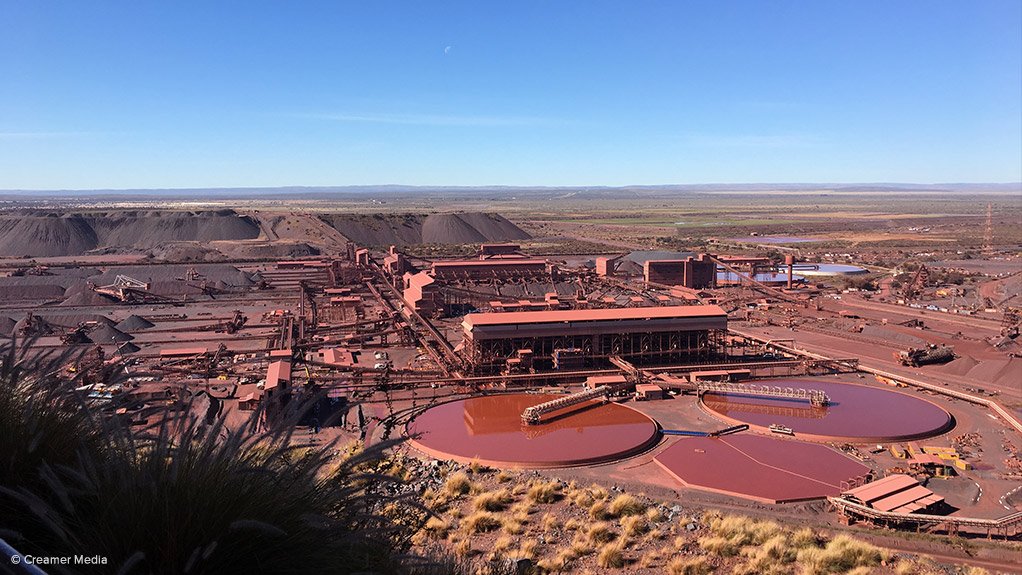The board of Kumba Iron Ore has approved a further R7.6-billion investment in ultrahigh dense media separation (UHDMS) processing technology at the Sishen mine, in the Northern Cape.
This follows the completion of a full technical review of the miner’s UHDMS project and is in addition to the R3.6-billion approved for the project in February 2021, taking the total capital investment in the project to R11.2-billion.
Kumba has already spent R1.8-billion on detailed engineering design, earthworks and the technical review. The remaining R9.4-billion will be invested between the second half of this year and the end of 2028, in line with the phasing of the project.
Full capacity is expected to be achieved by the end of 2028 and the company expects to achieve investment payback by 2029.
The investment will also extend Sishen’s life-of-mine to 2038 and open up the potential to extend the mine life further to 2044.
The UHDMS project will convert the current dense media separation processing plant at Sishen to UHDMS technology, which uses specialised ferrosilicon in the processing plant to separate valuable iron-ore from waste. This will provide Kumba with greater flexibility to process a wider range of iron grades and densities.
In a call with the media on August 29, Kumba CEO Mpumi Zikalala said the “compelling” investment would be a key differentiator for the company, enabling it to increase the volume of premium iron-ore produced at Sishen to about 55%, up from the current 18%.
She noted that quality iron-ore products sell at a premium and that demand for these premium products was rising globally, particularly in light of steelmakers’ goals to decarbonise their value chains.
“Premium iron-ore is increasingly highly valued by our customers because it reduces carbon emissions from the steelmaking process and so plays a key role in green steel production.”
She pointed out that Kumba’s customers would, as a result of the investment, be able to lower their Scope 3 emissions, while Kumba would be able to lower its own Scope 1 emissions.
Kumba executive head of marketing and seaborne logistics Dr Timo Smit said Kumba was currently unable to meet the demand of all customers wanting to buy premium lump product and that the increase in premium iron-ore production placed the miner in a position to “go after that demand”.
He said the company would pursue supply opportunities mainly outside of China, but would also sell to potential buyers in China.
By producing more premium iron-ore product, Kumba estimates that it will attract a selling price premium of $2/t to 3/t on average above the already-existing lump and iron premiums.
Further, by reducing the mining cut-off grade to 40% iron, from the current 48% iron grade, the waste stripping ratio improves to about 3.3 from about 3.9 currently, resulting in 15-million tonnes a year less waste mining required and a significant reduction in the cost of mining.
Kumba says the R11.2-billion investment in the UHDMS technology is expected to result in an earnings before interest, taxes, depreciation and amortisation margin of more than 50% and an internal rate of return of over 30%.
The implementation of the UHDMS will follow a modular approach, with six UHDMS coarse modules out of eight and five fines modules out of seven being converted.
Meanwhile, Zikalala stressed that it was crucial for the company and South Africa that the country’s logistics performance continue to improve.
She said Kumba had not factored in any significant improvements in State-owned Transnet’s performance in the financial projections for the UHDMS project, but nevertheless emphasised how critical it was for logistics reforms to continue to drive a turnaround in Transnet’s below-par performance in recent years.
Zikala added that she was confident that improvements would continue to be made.
Edited by: Creamer Media Reporter
EMAIL THIS ARTICLE SAVE THIS ARTICLE
ARTICLE ENQUIRY
To subscribe email subscriptions@creamermedia.co.za or click here
To advertise email advertising@creamermedia.co.za or click here













